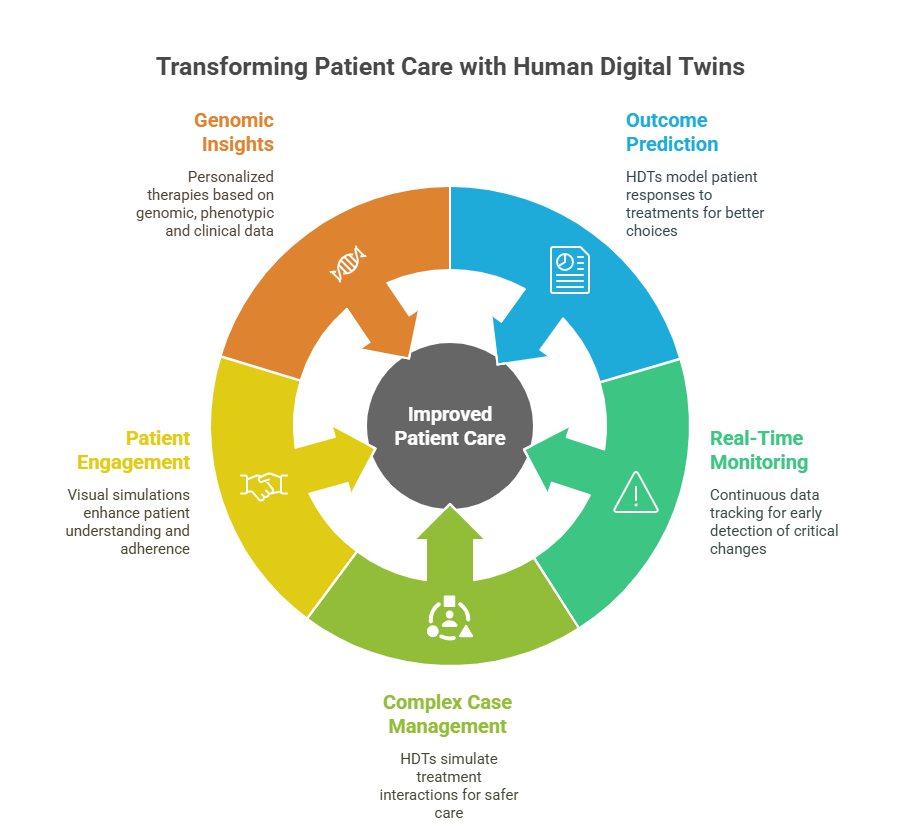
In today’s complex healthcare environment, experience and data aren’t always enough. But what if you could go beyond experience, lab results, and guidelines—and instead simulate personalized outcomes for every patient before making a move?
With Human Digital Twin technology, now you can.
A Human Digital Twin (HDT) is a virtual, real-time replica of a patient that integrates real-time data from electronic health records, genetics, imaging, wearable devices, and more. It’s not just a digital record—it’s a living, learning model that helps clinicians simulate treatments, predict outcomes, and deliver care that’s truly tailored to the individual.

At Mesh Bio, we’re helping healthcare providers tap into the full potential of this innovation through our HealthVector Diabetes® platform.
Here are five powerful ways Human Digital Twins are already transforming how we care for patients:
HDTs model how a patient’s unique physiology and medical conditions will respond to different treatment options. This empowers clinicians to explore multiple care pathways and select the ones with the best chance of favourable outcomes.
In action: A cardiologist can evaluate predicted responses to various blood pressure medications, cutting down on trial-and-error and speeding up control.
By continuously monitoring biometric and clinical data, HDTs can detect subtle changes before they manifest as symptoms. This enables timely intervention for critical issues like cardiac events or organ deterioration—supporting faster, life-saving action.
The impact: Faster responses, fewer avoidable hospitalizations, and better outcomes in high-risk cases.
Treating patients with multiple chronic conditions is often a delicate balancing act, where treating one issue can easily tip the scale on another. HDTs simulate how different treatments interact across systems—helping clinicians avoid adverse effects and fine-tune care plans for safety and effectiveness.
Result: Safer, more coordinated care for patients with diabetes, cardiovascular disease, and other complications.
When patients understand the “why” behind their care, they’re more likely to engage and stick to their treatment plans. HDTS offers clear, personalized visual simulations that make complex medical decisions easier to explain—and easier to trust.
Benefit: Greater patient engagement, increased adherence to treatment plan, and higher satisfaction.
HDTs combine clinical, phenotypic, and genomic data to help clinicians deliver highly personalized therapies based on predicted response—not just population averages or general guidelines. This is where medicine meets data science to unlock breakthrough outcomes.
In Action: Evaluate how a patient’s tumor will respond to immunotherapy versus chemotherapy—before starting treatment.

Why Partner with MeshBio?
At Mesh Bio, we work with healthcare systems, life sciences leaders, and research institutions to bring HDT technology into clinical practice—helping you make smarter, faster, more personalized decisions.
✅ Make faster, more confident clinical decisions
✅ Deliver more effective, personalized care for every patient
✅ Reduce clinical uncertainty and risk through real-time predictive insights
✅ Improve operational efficiency and patient outcomes
✅Drive the future of evidence-based medicine
Discover how next-generation clinical intelligence can transform your practice.
👉 Contact us today to schedule a demo and experience the power of Human Digital Twins Technology.